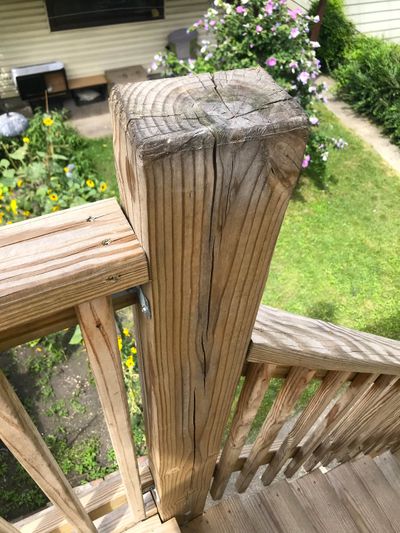Ask the Builder: Water loss causes shrinkage

Paula asked me a question about shrinkage cracks affecting her new deck. She sent me three photos showing all sorts of cracks in the handrails, railing posts, and the decking. The cracks were in brand new treated lumber installed in April of 2023. The wood has not been sealed since the day it was installed.
Paula asked, “I’m wondering whether it’s going to turn into a problem anytime soon.”
I’d say soon has already come and passed. Deep cracks are now in the wood. These cracks allow rainwater to penetrate into the wood. This water causes the wood to swell. Each time the sun comes out or the wind blows, the water leaves again causing repeated shrinkage. These swelling/shrinkage cycles cause the cracks to get bigger and bigger.
This is not the best analogy, but are you aware of the Centennial Light? It’s cared for by the Livermore-Pleasanton Fire Department in California. The light bulb was first turned on in 1901 and still burns today after being turned off briefly for a few times to be relocated.
Imagine if the treated lumber manufacturers stapled a small plastic care-instructions label on each piece of treated lumber. The label would tell you that you should seal the wood as soon as possible after installation. It would also inform you that keeping the wood sealed would allow it to last for many many decades much like the light bulb.
You can speculate why this label is not attached to the wood. The cynic in me screams that the wood industry is not overly upset that their wood cracks, twists, and warps. That way more new treated lumber might be purchased faster. I have no proof whatsoever this is their motivation, but a similar thing happened in the asphalt shingle industry. I cover this in my Roofing Ripoff book.
Water containing dissolved copper is injected under pressure into the wood when it’s converted from regular wood into treated wood. This causes the wood to swell. The wood cracks when the water leaves the wood too fast. Sealers allow for a slow steady release of the water. Cracks are minimized or eliminated. The application of the sealer just weeks after the treated lumber is put out in the sun and wind will keep it looking brand new.
The shrinkage happens in many building materials. It happened to me in the past 10 days. I applied blacktop sealer to a small patch of cold-patch asphalt. A small one-quarter-inch depression was in the patch. The water-based blacktop sealer was too thick in this spot. That spot was riddled with shrinkage cracks two days later.
Water loss in concrete causes shrinkage. The shrinkage creates tension, or pulling – forces within the concrete. Jagged random cracks in concrete will occur to relieve this tension unless you coax the concrete where to crack.
Concrete shrinks 1/16th inch for every 10 linear feet you pour. Expert concrete masons know to cut control joints in new concrete. The depth of these cut lines should be a minimum of 1/4th the thickness of the slab. The cut lines do the same thing as happens when you crease a piece of paper with your fingernail. The creasing action tears microscopic fibers in the paper. When you pull apart the paper carefully, it separates on the creased line.
Cracks in walls, woodwork, countertop backsplashes, and tile grout in new homes can all be traced to shrinkage caused by water loss. Seasonal cracks in plaster and crown molding happen because of water loss. Squeaking wood floors that mysteriously stop or start squeaking are also victims of water-related swelling or shrinkage.
Shrinkage cracks can be minimized or eliminated in most cases. Product installation instructions must be followed to the letter. Pay attention to wording about minimum and maximum temperature ranges.
You may find yourself in the same situation as Paula. Your outdoor lumber has cracked and water penetrates into the wood as fast as it goes into a sponge. I suggest you fill the cracks with an exterior spackling compound. Do a test and find one that matches the wood as closely as possible in color.
Seal or stain the spackling compound once it’s smooth and dry. Coat all the wood at the same time. Apply sealer at least every two years or when you see water fail to bead up on the wood.
You would do well to spend some time at my www.AsktheBuilder.com website. Discover more about concrete shrinkage cracks. All of my past columns and many answered emails are curated on my website. You can save money and time by getting up to speed on topics before you even think of calling in a contractor.
Subscribe to Tim Carter’s free newsletter at AsktheBuilder.com. Tim offers phone coaching calls if you get stuck during a DIY job. Go here: go.askthebuilder.com/coaching